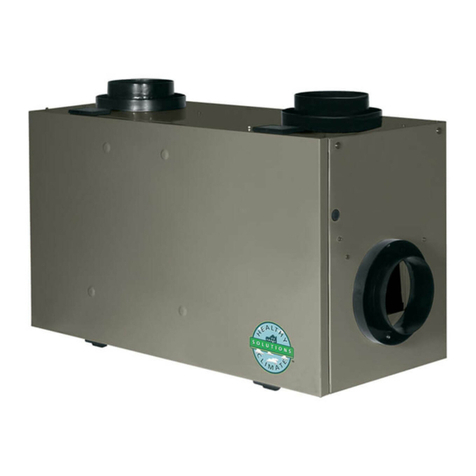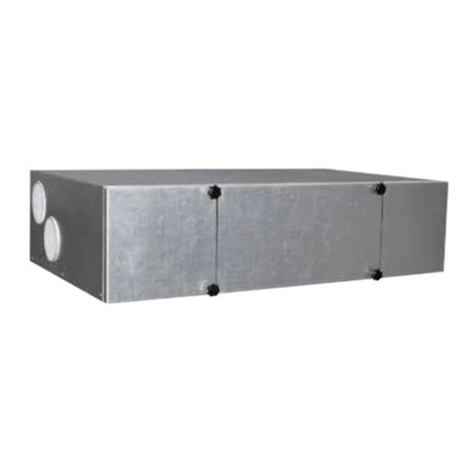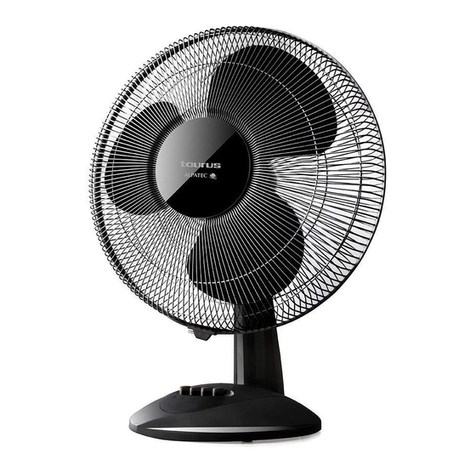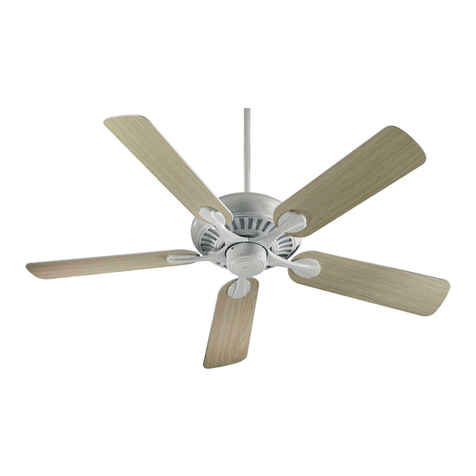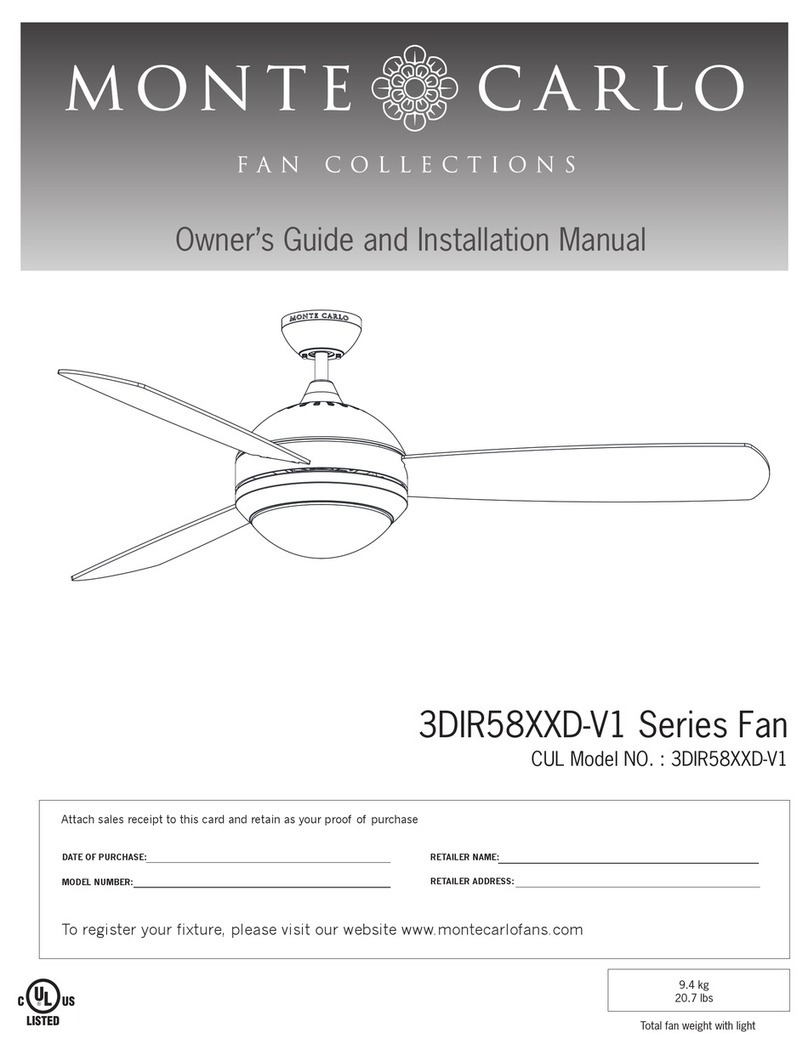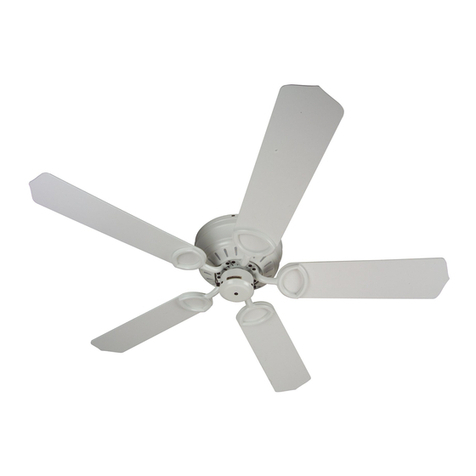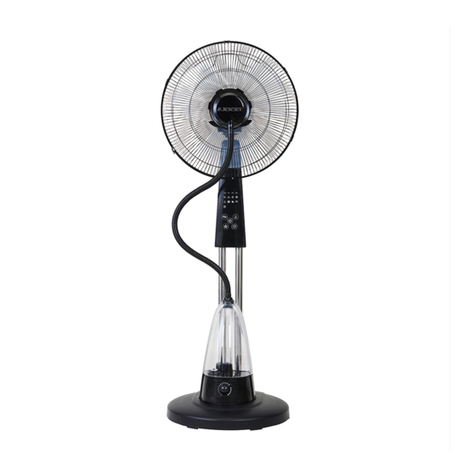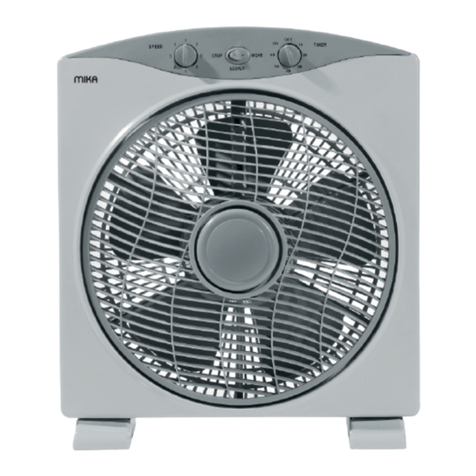Healthy Climate Solutions HEALTHY CLIMATE HRV3-095 User manual

12/12 506239−01
*2P1212* *P506239-01*
Page 1
INDOOR AIR QUALITY
KITS AND ACCESSORIES Litho U.S.A.
506239−01
12/12
Supersedes 05/12
HEALTHY CLIMATE®
HRV & ERV VENTILATORS
INSTALLATION INSTRUCTIONS & HOMEOWNERS GUIDE FOR HEALTHY CLIMATE®
HEAT RECOVERY VENTILATOR (HRV) & ENERGY RECOVERY VENTILATOR (ERV)
*HRV3−095
(Y2142)
*HRV3−095−GDX**
(Y2967)
THESE INSTRUCTIONS
MUST REMAIN WITH THE HOME-
OWNER FOR FUTURE REFERENCE
*These models have earned the ENERGY STAR® mark by meeting strict energy
efficiency guidelines set by Natural Resources Canada and the US EPA. These
models meet ENERGY STAR requirements only when used in Canada
ERV3−150
(Y2138)
ERV3−200
(Y2139)
HRV3−150−TPD
(Y5447)
HRV3−150−TPF
(Y5448)
*HRV3−195
(Y2143)
*HRV3−300
(Y2144)
Dual-core
(door re-
moved)
*HRV4−150
(Y5443)
*HRV4−200
(Y5444)
*HRV4−150−GDX**
(Y5445)
*HRV4−200−GDX**
(Y5446)
All Units
Conform to
CSA & UL
Standards
**Available in
Canada only
WARNING
Risk of property damage, injury or death.
Installation, adjustments, alterations, service and
maintenance must be performed by a qualified
service technician.
Shipping and Packing List
Package 1 of 1 contains:
1 − Assembled ventilator
1 − Bag assembly containing:
2 − Drain spout assemblies (HRV units only)
1 − Drain tee (HRV units only)
4 − Hanging straps
1 − Installation manual
1 − Warranty card
1 − Wall−mounted remote control
General Information
These instructions are intended as a general guide and do
not supersede local codes in any way. Consult authorities
who have jurisdiction before installation.
Table of Contents
Shipping and Packing List 1. . . . . . . . . . . . . . . . . . . . . . . . . . . . . . . . . .
General Information 1. . . . . . . . . . . . . . . . . . . . . . . . . . . . . . . . . . . . . . .
Terms & Definitions 2. . . . . . . . . . . . . . . . . . . . . . . . . . . . . . . . . . . . . . . .
Application 2. . . . . . . . . . . . . . . . . . . . . . . . . . . . . . . . . . . . . . . . . . . . . . .
Required Tools 2. . . . . . . . . . . . . . . . . . . . . . . . . . . . . . . . . . . . . . . . . . .
Ventilator Specifications & Performance Chart 3. . . . . . . . . . . . . . . . .
Ventilator Dimensions and Flow Diagrams 5. . . . . . . . . . . . . . . . . . . .
Defrost Cycle (HRV) 6. . . . . . . . . . . . . . . . . . . . . . . . . . . . . . . . . . . . . . .
HRV3−095 Port Configuration & Airflow 6. . . . . . . . . . . . . . . . . . . . . . .
Requirements 7. . . . . . . . . . . . . . . . . . . . . . . . . . . . . . . . . . . . . . . . . . . .
Controlling the Ventilators 8. . . . . . . . . . . . . . . . . . . . . . . . . . . . . . . . . .
Electronics 8. . . . . . . . . . . . . . . . . . . . . . . . . . . . . . . . . . . . . . . . . . . . . . .
Dehumidistat Operation 8. . . . . . . . . . . . . . . . . . . . . . . . . . . . . . . . . . . .
Ventilation Control 9. . . . . . . . . . . . . . . . . . . . . . . . . . . . . . . . . . . . . . . . .
Optional Timers 12. . . . . . . . . . . . . . . . . . . . . . . . . . . . . . . . . . . . . . . . . . .
Installation Methods 13. . . . . . . . . . . . . . . . . . . . . . . . . . . . . . . . . . . . . . .
Installing HRV/ERV Unit 17. . . . . . . . . . . . . . . . . . . . . . . . . . . . . . . . . . . .
Installing Drain Connection and Grilles 19. . . . . . . . . . . . . . . . . . . . . . .
Installing Weatherhoods 20. . . . . . . . . . . . . . . . . . . . . . . . . . . . . . . . . . . .
Installing Main Control 22. . . . . . . . . . . . . . . . . . . . . . . . . . . . . . . . . . . . .
Activating Dry Contact Controls/Elect. Connections 23. . . . . . . . . . . .
Installing/Operating Fan Timers 23. . . . . . . . . . . . . . . . . . . . . . . . . . . . .
Interlocking HRV/ERV to Furnace/Air Handler 24. . . . . . . . . . . . . . . . .
Electrical Connections (Wiring Diagrams) 24. . . . . . . . . . . . . . . . . . . . .
Airflow Balancing using Pitot Tube 28. . . . . . . . . . . . . . . . . . . . . . . . . . .
Airflow Balancing using the Door Ports 31. . . . . . . . . . . . . . . . . . . . . . .
Sequence of Operation 35. . . . . . . . . . . . . . . . . . . . . . . . . . . . . . . . . . . .
Troubleshooting 38. . . . . . . . . . . . . . . . . . . . . . . . . . . . . . . . . . . . . . . . . .
Replacement Part Summary 39. . . . . . . . . . . . . . . . . . . . . . . . . . . . . . . .
Homeowner Maintenance Information 41. . . . . . . . . . . . . . . . . . . . . . . .
Ventilator Application MapHRV/ERV Ventilators 42. . . . . . . . . . . . . .

Page 2
12/12
Terms & Definitions
Defrost Mode (HRV)to ensure reliable operation during
cold weather, the HRV will automatically cycle through its
defrost mode as needed.
Dehumidistata control device that senses the amount
of moisture in the air and activates high−speed ventilation
when the air moisture level exceeds the set point.
Resetwhenever resetting of the HRV/ERV is required,
simply unplug the power cord for 30 seconds. The Self Test
will occur when the HRV/ERV is reconnected.
Self Testeach time the HRV/ERV is powered/ener-
gized, the self test function will automatically initiate. Dur-
ing the self test, the HRV/ERV will cycle through all the
speeds available (1 − 5), test the damper motor operation,
and will default back to the previous operational mode and
speed selection. Total self test duration is approximately
90 seconds.
Standby Modethe HRV/ERV is powered/energized and
waiting for fan operation to be initiated. For example, the
HRV is set to Continuous Ventilation Operational Mode at
speed 0.
Thermistorthe HRV/ERV’s temperature sensor which
measures electrical resistance in a known manner, as out-
door temperatures fluctuate.
HVIHome Ventilating Institute.
R2000Canada Home Building Energy Efficiency Stan-
dard.
HRAIHeating Refrigeration Air Conditioning Institute.
Application
The Healthy Climate® Heat Recovery Ventilator (HRV)
and Energy Recovery Ventilator (ERV) are designed to
provide fresh air while exhausting an equal amount of stale
air. Refer to application map on page 42.
The HRV unit is equipped with an aluminum core. The de-
vice uses the stale air that is being exhausted to condition
the fresh air as it is being brought in.
The ERV unit is equipped with an enthalpic core. This de-
vice is designed for use in warm, humid climates with
heavy air conditioning loads. The ERV unit transfers both
sensible (temperature) and latent (moisture) heat from in-
coming fresh air to the stale air as it is being exhausted;
thus, reducing the air conditioning load. The ERV unit is not
suitable for use in climates where the temperature drops
below 25ºF (−4ºC) for more than 5 days continuously.
Required Tools/Materials
Recommended Materials
low voltage control wire mastic tape
1/2˜ I.D. drain hose caulking material
aluminum foil duct tape zip ties (duct)
fabric flexible duct − class II rated zip ties
Balancing Tools − Various Options
Pitot Tube Balancing Kit (Case, 8 ft. vinyl tubing,
Pitot tube, magnehelic gauge [0 − 0.25˜], &
mounting plate) 56N82. . . . . . . . . . . . . . . . . . . . . . . . . . . .
Magnehelic Gauge only (0 − 0.25˜) 79P83. . . . . . . . . . . . .
Pitot Tube only 72X52. . . . . . . . . . . . . . . . . . . . . . . . . . . . . .
Digital Manometer with resolution of 0 − 0.25˜ (must
read to 1/100ths of an inch) 86N62. . . . . . . . . . . . . . . . . .
Door Port Balancing Kit for
HRV3−150/200, (Y2140/Y2141) only (kit includes
case, magnehelic gauge (0 − 0.50˜), 2 connection
hoses, 4 rubber fittings & instructions) Y2206. . . . . . . . . .
Door Port Balancing Kit without magnehelic
gauge included. To be used with magnehelic
gauge (0 − 0.50˜) or digital manometer (reading
down to 0 with resolution of .001˜) bought
separately. (kit includes 2 connection hoses,
4 rubber fittings and instructions). Y2207. . . . . . . . . . . . . .
Optional Accessories
20 Minute Fan Timer Y2168. . . . . . . . . . . . . . . . . . . . . . . . .
20/40/60 Minute Fan Timer Y2169. . . . . . . . . . . . . . . . . . .
Digital Control (wall mounted) Y2171. . . . . . . . . . . . . . . . .
Programmable Control (wall mounted) Y2172. . . . . . . . .
Weatherhood Kit (includes 2 hoods, 2 screens,
2 12" sleeves, 2 collars and supply/exhaust labels):
5˜ (127 mm) 92E66. . . . . . . . . . . . . . . . . . . . . . . . . . . . .
6˜ (152 mm) 95P07. . . . . . . . . . . . . . . . . . . . . . . . . . . . .
7˜ (178 mm) 17N11. . . . . . . . . . . . . . . . . . . . . . . . . . . . .
Round Diffusers:
4˜ (102 mm) 92E54. . . . . . . . . . . . . . . . . . . . . . . . . . . . .
5˜ (127 mm) 92E55. . . . . . . . . . . . . . . . . . . . . . . . . . . . .
6˜ (152 mm) 92E56. . . . . . . . . . . . . . . . . . . . . . . . . . . . .
8˜ (203 mm) 56N81. . . . . . . . . . . . . . . . . . . . . . . . . . . .
Dual Hood kit (includes hood assembly, foam gasket,
duct splitter, duct insulator, retainer screw assembly,
nylon cable tie, screens, labelled Supply/Exhaust.
6" (152 mm) Y3813. . . . . . . . . . . . . . . . . . . . . . . . . . . . . . . .
Kitchen Grille, 6" x 10"(152mm x 254mm)) (May
be required by code for kitchen applications;
contains removable grease filter) 18N48. . . . . . . . . . . . .
Back Draft Dampers:
5" (127 mm) Y3728. . . . . . . . . . . . . . . . . . . . . . . . . . . . .
6" (152 mm) Y3727. . . . . . . . . . . . . . . . . . . . . . . . . . . . .
Butterfly Balancing Dampers:
6˜ (152 mm) 91X09. . . . . . . . . . . . . . . . . . . . . . . . . . . . .
7˜ (178 mm) field supplied. . . . . . . . . . . . . . . . . . . . .
Duct Heaters:
6˜ (152 mm) 1KW 97E73. . . . . . . . . . . . . . . . . . . . . . . .
6˜ (152 mm) 2KW 20N16. . . . . . . . . . . . . . . . . . . . . . .
7˜ (178 mm) 2KW 97E74. . . . . . . . . . . . . . . . . . . . . . . .

Page 3 Healthy Climate®HRV/ERV Ventilators
Specifications Single−Core HRV Units Dual−Core HRV Units Single−Core ERV
Units
Model No.
HRV3
−150−TPD
(Y5447)
HRV3
−150−TPF
(Y5448)
HRV3
−095/−095−GDX
(Y2142/Y2967)
HRV4
−150/−150−GDX
(Y5443/ Y5445)
HRV4
−200/−200−GDX
(Y5444/Y5446)
HRV3−195
(Y2143)
HRV3−300
(Y2144)
ERV3−150
(Y2138)
ERV3−200
(Y2139)
Energy Star®qualified
(Canada Only) No No Yes Yes Yes Yes Yes No No
Cabinet Size (Inches) 14 x 17−1/4 x
22−3/4
14 x 17−1/4 x
22−3/4
16 x 24-1/2 x
18-1/2
14-3/4 x 19 x
33-5/8
14-3/4 x 19 x
33-5/8
14-3/4 x 19
x 49
14-3/4 x 19
x 49
14-3/4 x 19
x 33-5/8
14-3/4 x 19
x 33-5/8
Weight 51 51 52 71 71 106 106 75 75
Shipping Weight 54 54 56 73 73 108 108 77 77
in. w.g. (Pa) High Speed (HVI Certified)
0.1 (25) 156 (74) 174 (82) 76 (36) 148 (87) 184 (87) 216 (101) 232 (110) 151 (71) 180 (85)
0.2 (50) 146 (69) 165 (77) 73 (34) 130 (62) 183 (77) 195 (92) 212 (100) 141 (67) 169 (79)
0.3 (75) 134 (63) 154 (73) 70 (33) 116 (55) 146 (69) 181 (85) 202 (95) 132 (62) 157 (74)
0.4 (100) 124 (59) 143 (67) 66 (31) 103 (49) 132 (62) 158 (74) 183 (86) 124 (59) 146 (69)
0.5 (125) 115 (54) 132 (62) 60 (28) 90 (42) 115 (54) 144 (68) 163 (77) 107 (50) 132 (62)
0.6 (150) 104 (49) 120 (56) 72 (34) 92 (43) 125 (59) 144 (68) 98 (46) 118 (55)
0.7 (175) 95 (454) 107 (521) 49 (23) 60 (28) 107 (50) 123 (58) 81 (38) 101 (47)
0.8 (200) 85 (40) 95 (45) 72 (34) 92 (43) 60 (28) 82 (39)
Sensible Effectiveness
@ 32ºF (0ºC)
@ 66 CFM
(31 L/s) 74%
@ 66 CFM
(31 L/s) 75%
@ 60 CFM (28
L/s) 88%
@ 60 CFM (28
L/s) 85%
@ 59 CFM (28
L/s) 84%
@ 114 CFM
(54 L/s) 86%
@ 117 CFM
(55 L/s) 90%
@ 63 CFM
(30 L/s) 81%
@ 116 CFM
(55 L/s) 76%
Sensible Efficiency
@ 32ºF (0ºC)
@ 66 CFM
(31 L/s) 61%
@ 66 CFM
(31 L/s) 66%
@ 60 CFM (28
L/s) 75%
@ 60 CFM (28
L/s) 75%
@ 59 CFM (28
L/s) 75%
@ 114 CFM
(54 L/s) 78%
@ 117 CFM
(55 L/s) 79%
@ 63 CFM
(30 L/s) 69%
@ 116 CFM
(55 L/s) 69%
Sensible Efficiency
@ −13ºF (−25ºC)
@ 76 CFM
(31 L/s) 73%
@ 65 CFM
(30 L/s) 56%
@ 61 CFM (29
L/s) 68%
@ 65 CFM (31
L/s) 73%
@ 64 CFM (30
L/s) 72%
@ 112 CFM
(53 L/s) 72%
@ 132 CFM
(62 L/s) 70% N/A N/A
Latent Efficiency
95ºF (35ºC) N/A N/A N/A N/A N/A N/A N/A @ 65 CFM
(30 L/s) 37%
@ 117 CFM
(55 L/s) 41%
Total Efficiency
95ºF (35ºC) N/A N/A N/A N/A N/A N/A N/A @ 65 CFM
(30 L/s) 47%
@ 117 CFM
(55 L/s) 50%
Number of speeds available
with included wall control 2 2 2 2 2 2 2 1 1
Number of speeds available
with optional wall control 5 5 5 5 5 5 5 5 5
Ventilator Type Heat
Recovery
Heat
Recovery Heat Recovery Heat Recovery Heat Recovery Heat
Recovery
Heat
Recovery
Energy
Recovery
Energy
Recovery
Heat/Energy Recovery Core Aluminum Aluminum Aluminum Aluminum Aluminum Aluminum Aluminum Enthalpic Enthalpic
Number of HRV/ERV Cores 1 1 1 1 1 2 2 1 1
Defrost Type Recirculating Fan Recirculating Recirculating Recirculating Damper Damper None None
Door Port Balancing Yes Yes No Yes Yes No No No No
Balancing Damper in
Supply & Exhaust Collar Yes Yes No Yes Yes No No Yes Yes
Number of Ports 4 4 4 4 4 5 5 4 4
Pre-Filters (Foam) Supply &
Exhaust Yes Yes Yes Yes Yes Yes Yes Yes Yes
Wall Controller Included Y2166 Y2166 Y2166/Y2171 Y2166/Y2171 Y2166/Y2171 Y2166 Y2166 N/A N/A
H/C ERV Wall Control−
on/off, Service Indicator
(Y2165)
N/A N/A N/A N/A N/A N/A N/A Yes Yes
Electrical Characteristics 120 Volts, 60 Hertz, 1 phase
Fan HP 1/20 1/20 1/20 1/20 1/10 1/10 1/4 1/20 1/10
Motor Type PSC PSC PSC PSC PSC PSC PSC PSC PSC
Fan Watts − High Speed
@ 0.3 in. w.g. 110 118 150 110 118 173 333 173 182
Fan Watts − Low Speed
@ 0.3 in. w.g. 57 66 60 57 66 100 150 63 70
Amp Rating 1.3 1.4 0.9 1.3 1.4 1.5 2.9 1.4 1.4
Condensate Drain
Connections:
Spouts: qty. 2 (1/2" o.d.)
Drain Tee: qty. 1 (1/2" o.d.)
Yes Yes Yes Yes Yes Yes Yes N/A N/A
table continued on next page

Page 4
12/12
Single−Core ERV
Units
Dual−Core HRV UnitsSingle−Core HRV Units
Specifications
Model No. ERV3−200
(Y2139)
ERV3−150
(Y2138)
HRV3−300
(Y2144)
HRV3−195
(Y2143)
HRV4
−200/−200−GDX
(Y5444/Y5446)
HRV4
−150/−150−GDX
(Y5443/ Y5445)
HRV3
−095/−095−GDX
(Y2142/Y2967)
HRV3
−150−TPF
(Y5448)
HRV3
−150−TPD
(Y5447)
OPTIONAL FAN CURVES SPEEDS (FACTORY TESTED)
Speed 4−med high
in. w.g. (Pa) CFM (L/s) CFM (L/s) CFM (L/s) CFM (L/s) CFM (L/s) CFM (L/s) CFM (L/s) CFM (L/s) CFM (L/s)
0.1 (25) 70 (33) 125 (59) 153 (72) 167 (78) 220 (103) 120 (56) 151 (71)
0.2 (50) 65 (31) 112 (53) 141 (67) 159 (75) 202 (94) 111 (52) 147 (69)
0.3 (75) 50 (24) 103 (49) 131 (62) 150 (71) 186 (87) 103 (48) 129 (61)
0.4 (100) 101 (48) 101 (48) 31 (15) 87(41) 117 (55) 140 (66) 169 (79) 92 (43) 118 (55)
0.5 (125) 91 (43) 91 (43) 83 (39) 96 (45) 124 (58) 158 (74) 80 (38) 104 (49)
0.6 (150) 82 (39) 82 (39) 67 (32) 80 (38) 110 (52) 134 (62) 64 (30) 89 (42)
0.7 (175) 69 (33) 69 (33) 49 (23) 93 (44) 108 (50) 43 (20) 63 (30)
0.8 (200) 60 (28) 60 (28) 79 (37)
Speed 3−med
0.1 (25) 65 (31) 112 (53) 144 (68) 142 (67) 194 (91) 97 (46) 133 (63)
0.2 (50) 60 (28) 99 (47) 130 (61) 136 (64) 178 (83) 87 (41) 130 (61)
0.3 (75) 92 (43) 92 (43) 48 (23) 83 (39) 120 (57) 127 (60) 170 (79) 81 (38) 124 (58)
0.4 (100) 82 (39) 82 (39) 30 (14) 76 (36) 106 (50) 118 (55) 154 (72) 72 (34) 114 (54)
0.5 (125) 71 (34) 71 (34) 71 (34) 88 (42) 103 (48) 139 (65) 61 (29) 104 (49)
0.6 (150) 60 (28) 60 (28) 57 (27) 92 (43) 118 (55) 53 (25) 94 (44)
0.7 (175) 40 (19} 72 (34) 94 (44) 80 (38)
0.8 (200)
Speed 2−med low
0.1 (25) 62 (29) 87 (41) 127 (60) 115 (54) 170 (79) 73 (34) 112 (53)
0.2 (50) 81 (38) 81 (38) 54 (25) 74 (35) 116 (55) 107 (50) 163 (76) 67 (31) 107 (50)
0.3 (75) 70 (33) 70 (33) 42 (20) 69 (33) 106 (50) 100 (47) 151 (70) 59 (28) 101 (47)
0.4 (100) 60 (28) 60 (28) 26 (12) 57 (27) 97 (46) 90 (42) 136 (63) 51 (24) 96 (45)
0.5 (125) 46 (22) 46 (22) 51 (24) 86 (40) 81 (38) 129 (60) 45 (21) 88 (41)
0.6 (150) 44 (21) 66 (31) 107 (50) 77 (36)
0.7 (175) 32 (15) 88 (41) 60 (28)
0.8 (200)
Speed 1−low
0.1 (25) 51 (24) 65 (31) 108 (51) 88 (41) 144 (67) 53 (25) 88 (41)
0.2 (50) 61 (29) 61 (29) 45 (21) 56 (26) 100 (47) 80 (38) 137 (64) 44 (21) 85 (40)
0.3 (75) 49 (23) 49 (23) 33 (16) 40 (19) 91 (43) 73 (34) 134 (62) 38 (18) 80 (38)
0.4 (100) 35 (17) 35 (17) 18 (8) 36 (17) 78 (37) 63 (30) 121 (56) 32 (15) 77 (36)
0.5 (125) 32 (15) 56 (26) 110 (51) 67 (31)
0.6 (150) 30 (14) 43 (20) 95 (44)
0.7 (175) 84 (39)
0.8 (200)
OPTIONAL ACCESSORIES−MUST BE ORDERED EXTRA
Backdraft Damper 5" Y3728 Y3728 Y3728 N/A N/A N/A N/A N/A N/A
Backdraft Damper 6" N/A N/A N/A Y3727 Y3727 Y3727 Y3727 Y3727 Y3727
Butterfly Damper, 6" N/A N/A 91X09 Included in the unit N/A N/A Included in the unit
Butterfly Damper, 7" N/A N/A N/A N/A N/A Field Supplied N/A N/A
Insulated Flexible Ducting:
(Qty Req’d) Dia. (2) 5 (2) 5 (2) 5 (2) 6 (2) 6 (2) 6 (2) 6 (2) 6 (2) 6
COMMON ACCESSORIES − AS REQUIRED, BASED ON USER APPLICATION
Door Port Balancing Kit N/A N/A Y2206
(same kit w/o Gauge) Y2207
Digital Handheld
Manometer 86N62
Magnehelic Gauge only
(0-0.25") N/A N/A 79P83
Pitot Tube Balancing Kit N/A N/A 56N82
Pitot Tube only 72X52

Page 5 Healthy Climate®HRV/ERV Ventilators
Ventilator Dimensions and Flow Diagrams
HRV3−195/300
19"
(483 mm)
14−3/4" (375 mm)
NOTE − Front clearance of
25 inches (635 mm) is
recommended for
servicing unit
RECIRCULATING
DEFROST
DAMPER
FILTERS
STALE AIR FROM INSIDE
CONDENSATE
DRAINS
BALANCING
DAMPER
FRESH
AIR TO
INSIDE
STALE
AIR TO
OUTSIDE
*All Duct
Connections
6" (152 mm)
FRESH AIR FROM OUTSIDE
MOTOR
HRV4−150/200
FILTER
STALE AIR
FROM INSIDE
BALANCING DAMPER
FRESH
AIR TO
INSIDE
STALE
AIR TO
OUTSIDE
BLOWER
*All Duct
Connections
6" (152 mm)
FRESH AIR
FROM OUTSIDE CORE
ERV3−150/200
BALANCING DAMPER
19"
(483 mm)
NOTE − Front clearance of
25 inches (635 mm) is
recommended for
servicing unit
NOTE: DRAWING DEPICTS HRV3−300; MODEL
HRV3−195 MOTOR IS AT TOP BLOWER
DEFROST
DAMPER
DEFROST AIR
FROM INSIDE
FILTER
CONDENSATE DRAINS
FRESH
AIR TO
INSIDE
STALE AIR
FROM
INSIDE
BLOWER
FRESH
AIR
FROM
OUT-
SIDE
MOTOR (SEE
NOTE BELOW)
CORE
FILTER
CORE
STALE
AIR TO
OUT-
SIDE
33−5/8" (854 mm)
33−5/8" (854 mm)
49" (1245 mm)
BLOWER
BLOWER
14−3/4" (375 mm)
19"
(483 mm)
NOTE − Front clearance of
25 inches (635 mm) is
recommended for
servicing unit
14−3/4" (375 mm)
Duct Connections
7" (178 mm)
Duct
Connections
6" (152 mm)
MOTOR
FILTER
HRV3−150−TPD/TPF
FRESH AIR
FROM
OUTSIDE
STALE
AIR FROM
INSIDE
FRESH
AIR TO
INSIDE
STALE
AIR TO
OUTSIDE
DEFROST
DAMPER
(ONLY ON TPD)
BLOWER BLOWER
17.25"
(438 mm)
14" (358 mm)
NOTE − Front clearance of
25 inches (635 mm) is
recommended for servicing unit
BALANCING DAMPERS ARE
LOCATED ON ALL COLLARS
ALL DUCT CONNECTIONS
ARE ELLIPTICAL COLLARS
FOR USE WITH 5 IN. (125 MM)
DUCTWORK.
33−5/8" (854 mm)
22.75" (578 mm)
BALANCING DAMPER

Page 6
12/12
HRV3−095 Port Configuration & Airflow
THREADED INSERTS
(4) at corners
FILTER
(in back
chamber)
18−1/2" (470 mm)
FRESH AIR
TO INSIDE
(Supply) 6"
(178 mm)
round
(converted to
oval collar)
STALE AIR TO OUT-
SIDE (Exhaust) 5" (127
mm) round collar
STALE AIR FROM IN-
SIDE (Exhaust) 6" (178
mm) round (converted
to oval) collar supplied
FRESH AIR
FROM
OUTSIDE
(Supply) 5"
(127 mm)
round collar
ADJUSTABLE HANGING
STRAPS WITH S HOOK (4)
DRAIN
SPOUT
DRAIN
PAN
CORE
24−1/2"
(622 mm)
16"
(406 mm)
18−1/2"
(470 mm)
18 inches (457
mm) (min.) required
for service access
TOP VIEW
HRV3−095
ÎÎÎ
ÎÎÎ
ÎÎÎ
ÎÎÎ
ÏÏÏ
ÏÏÏ
ÏÏÏ
FRESH
AIR
FROM
OUT-
SIDE
FRESH
AIR TO
INSIDE
STALE
AIR TO
OUT-
SIDE
STALE AIR FROM INSIDE
DIVIDER PANEL
(each side)
FILTER
(in front
chamber)
A
B
A
BD
D
C
A
B
D
C
C
HRV3−095 Air Flow Direction
The top half of the unit is divided front to back. This unique configuration allows the air to actually travel through the core
twice, making the HRV3−095 unit almost as efficient as a double core unit.
Stale air enters the front right side port. The air will pass down the front half of the core, then up the back half of the core
and out the right rear port.
Fresh outdoor air will enter the left rear port and pass down the back half of the core. It will then pass up the front half of the
core, and out the left front port.
Defrost Cycle (HRV)
The HRV has an electronically controlled defrost system.
The defrost cycle is activated when the outdoor tempera-
ture drops below 27ºF (−3ºC). There are three levels of de-
frost mode based on the outdoor temperature. Incoming
fresh air is measured to set the defrost times and the run
times while in the defrost mode. The three defrost settings
are:
SAt 27ºF (−3ºC) HRV runs in defrost for 3 minutes and
runs in ventilation for 25 minutes
SAt −4ºF (−20ºC) HRV runs in defrost for 4.5 minutes and
runs in ventilation for 17 minutes
SAt −31ºF (−35ºC) HRV runs in defrost for 7 minutes and
runs in ventilation for 15 minutes
No remote device can override this defrost mode or se-
lected speed until the cycle is complete. After the cycle is
completed the HRV defaults to previous settings. If the
cycle is completed and the thermistor continues to mea-
sure defrost temperature the defrost cycle is repeated.
ERV’s have no defrost cycle and are not recommended
where outdoor temperatures fall below 25ºF (−4ºC) contin-
uously for more than 5 days.
Recirculating Damper Defrost (HRV3−095,
HRV3−150−TPD, HRV4−150, HRV4−200)
During defrost a motor driven damper door mechanism
closes off the supply air from outside allowing exhaust air
to recirculate through the unit’s core. During defrost cycle
no ventilation is occurring. After the defrost period, the
damper operates in the opposite direction to reopen the
fresh air port. Defrost cycle repeats until the temperature
rises above 27ºF (−3ºC).
Damper Defrost − 5 port Models (HRV3−195/300)
During defrost a motor driven damper door mechanism
closes off the supply air from outside allowing a fifth port to
open enabling warm air to be drawn in from around the
unit. During defrost cycle stale air exhaust is still occurring.
After the defrost period, the damper operates in the oppo-
site direction to reopen the fresh air port. Defrost cycle re-
peats until the temperature rises above 27ºF (−3ºC). (The
defrost port can also be ducted to another location.)
Fan Defrost (HRV3−150−TPF)
During defrost cycle, the Fresh Air supply motor will shut
off and the Stale Air exhaust motor will continue to run.
After the defrost period, the Fresh Air supply motor will re-
sume. Defrost cycle repeats until the temperature rises
above 27ºF (−3ºC).
6" Diameter
SAME CIRCUMFERENCE
In order to make the HRV3−095 unit as space efficient as possible, the
indoor supply and return ports are converted from round to oval
shape. Circumference of the port remains the same. Simply bend a
standard duct fitting to the correct shape, and attach to the oval port
using the same method as for a round port.
Figure 1. Shaping Ducting to fit Oval Indoor
Supply Port

Page 7 Healthy Climate®HRV/ERV Ventilators
Requirements
Connecting appliances to the HRV/ERV unit
The following appliances should not be connected to the HRV/ERV unit:
Sclothes dryer
Srange top
Sstove top fan
Scentral vacuum system
NOTE − Failure to follow this instruction will void the HRV/ERV unit warranty.
DANGER
Risk of Carbon Monoxide Poisoning and/or Explosion.
Can cause injury or death.
Combustion and flue gases from heating appliances must never be allowed to enter living spaces.
HRV/ERV unit must be properly balanced (see page 28 or 31) to prevent negative pressure in structure. Negative
pressure can cause back−drafting of combustion gases in other household appliances such as Gas Furnaces,
Oil Furnaces, Hot Water Heaters, Wood Stoves, Fireplaces, etc.
(5-Port HRV models only) Defrost cycles will cause negative pressure in equipment room. Install ductwork and
route to areas that do not contain appliances with vented combusted gases.
Never connect a return or supply duct to other heating units such as fireplaces, wood stoves.
CAUTION
Potential equipment malfunction or damage.
May require repairs and/or void warranty.
Do not interconnect HRV/ERV to other appliances such as Stove Vents, Clothes Dryer Vents, Central Vacuum
Systems, Auxiliary Fans, etc.

Page 8
12/12
Controlling the HRV/ERV
Today’s modern, air tight homes require fresh outdoor air
to maintain a healthy indoor air environment. The amount
of ventilation required in a home depends upon:
Sthe number of occupants and their activity levels.
Sthe way the home was built,
Spersonal preferences for fresh air.
The HRV/ERV introduces fresh air to your home while re-
covering energy from the air it exhausts. Specifically, an
HRV/ERV that is properly installed, operated, and main-
tained will:
Sexhaust stale, contaminated air,
Srecover the majority of the energy from the exhausted
stale air,
Suse the recovered energy to preheat or precool out-
side air that is drawn into the house,
Sdistribute the fresh air throughout the house.
How much ventilation is needed?
During seasons when windows and doors are closed (win-
ter and summer, if air conditioned) the HRV/ERV should be
set to operate continuously on low speed with the option of
going to high speed as the need arises. For example, if a
large number of people are present in the home, the unit
should be switched temporarily to high speed. Conversely,
when the home is unoccupied, an intermittent operational
mode (e.g. 20 minutes on / 40 minutes off) may be used.
Electronics
All units include a Wall Control. Optional controls can be
installed at the time of the installation or at a later date, pro-
viding a number of choices for upgrading the basic fea-
tures of the ventilation system.
Dehumidistat Operation
Often, well insulated and air tight homes will have high in-
door humidity levels during the heating season. High hu-
midity levels are apparent from the visible condensation on
windows. The amount of condensation on the windows will
increase as outdoor temperatures drop.
The HRV/ERV will reduce indoor humidity levels when out-
door air is drier than indoor air. This usually occurs during
the heating season when outdoor temperatures are less
than 59ºF (15ºC).
HRV controls include a dehumidistat function which can be
set to achieve a dehumidification effect from the HRV dur-
ing the winter heating season. High-speed ventilation will
be initiated upon exceeding the dehumidistat set point.
Once the humidity in the house is reduced, the HRV will re-
vert back to its previous setting.
It is recommended that the unit be operated for the first few
days without use of the dehumidistat function to observe if
a further dehumidification effect will be required. The dehu-
midistat operates in % of RH (relative humidity) with 80 be-
ing high and 20 being low. Set the Dehumidistat to 80% RH
to disable. If, after a few days, further dehumidification is
required (the house is too humid), set the humidity level to
a lower setting. Comfortable humidity levels range be-
tween 30 and 50% RH, depending on personal preference.
The dehumidistat should be off for all seasons except the
heating season (set to 80% RH).
Synchronizing the Humidity Setting
The optional wall controls (Y2171 and Y2172) have a fea-
ture that allows the controls to be synchronized with other
humidity instruments in the home. To synchronize:
1. Turn off the control with the ON/OFF button.
2. Simultaneously press and release the ON/OFF button
and the 20/40/60 minute high−speed override button.
3. Use the Up/Down arrow buttons to adjust the Humidity
Indicator on the display screen to the number of de-
grees difference between your humidity measuring
device. Minus is indicated by flashing.
4. Press the MODE button.
Dehumidistat Disable Feature
The new auto dehumidistat function prevents unwanted
use of the dehumidistat when outdoor temperature ex-
ceeds 59ºF (15ºC).
The dehumidistat function will be disabled if the outdoor
temperature exceeds 59ºF (15ºC) for a 24−hour period.
The dehumidistat function will be re-enabled if the unit is
unplugged for 3 minutes or if the outdoor temperature
drops below 59ºF (15ºC) for a 24-hour period. The dehumi-
distat disable feature is permanently enabled in the ERV
unit.

Page 9 Healthy Climate®HRV/ERV Ventilators
Ventilation Controls (included)
ERV Ventilation Control (Y2165)
Home ventilation provided by the ERV unit is easily con-
trolled with included ERV Ventilation System control.
Key features
SON/OFF button with ON LED
SService indicator
SConnect to 3−wire, 20−gauge (min.), low−voltage wire.
UNIT ON/OFF ControlPress and release the ON/OFF
button. ON" indicator light illuminates; press again to turn
OFF.
Service Indicator LEDAfter 4 months, a SERVICE" in-
dicator will appear. Refer to Homeowner Maintenance In-
formation, page 41. Upon completion of maintenance, re-
set service light by pressing and holding RESET button for
5 seconds.
HRV Ventilation Control (Y2166)**
Home ventilation provided by the HRV unit is easily con-
trolled with included HRV Ventilation System control.
**HRV −GDX (Canada only) units come with Y2171 Digital
2−Speed/4−Mode Control (see figure 4, Page 10).
Key features
SON/OFF button with ON LED
SDehumidistat with LED indications
SService indicator
SConnect to 3−wire, 20−gauge (min.), low−voltage wire.
UNIT ON/OFF ControlPress and release the ON/OFF
button. ON" indicator light illuminates; press again to turn
OFF.
Humidity ControlUnit will produce a dehumidifying ef-
fect when outdoor humidity levels are lower than indoor
humidity levels. Dehumidistat should not be used when
outdoor temperatures are above 59ºF (15ºC). Press and
release DEHUMIDISTAT button until the DEHUMIDISTAT
LED is at the desired setting. After seconds, the dehumi-
distat light will either flash or be on continuously. A flashing
light indicates the humidity level is higher than the setting
and the unit is operating on high−speed ventilation. A con-
tinuous light indicates the humidity level is lower than the
setting.
NOTE − Only 1 dehumidistat should be active on a system.
Service Indicator LEDAfter 4 months, a SERVICE" in-
dicator will appear. Refer to Homeowner Maintenance In-
formation, page 41. Upon completion of maintenance, re-
set service light by pressing and holding RESET button for
5 seconds.
Instruction Card
Service
Indicator LED
Service Reset
Button
ON/OFF
Button
ON LED
Figure 2. ERV Control (Y2165)
Dehumidistat
Indicator LEDs
ON LED
ON/OFF
Button
Service
Indicator LED
Service Reset
Button
Instruction Card
Figure 3. HRV Control (Y2166)

Page 10
12/12
Ventilation Controls (optional)
* NOTE: Recirculation is available on HRV3−095, HRV3−150,
HRV3−200 only.
4-Mode Descriptions
The two optional digital controls have 4 operational modes
and 2 or 5 speeds on each mode to adjust indoor ventila-
tion levels. Experiment with the ventilation levels in the
home to evaluate the best amount of ventilation to suit the
homeowner needs and preferences.
1. Continuous Ventilation Mode (VENT)
This is the most popular mode since it provides contin-
uous ventilation within the home. You may, for exam-
ple, select Continuous Ventilation at high speed for
high household activity levels, or Continuous Ventila-
tion at low speed for lower activity levels.
2. 20 minutes ON, 40 minutes OFF Mode (20/40)
This mode provides 20 minutes of ventilation each
hour. Use this mode in low speed for low household ac-
tivity levels or if the home is unoccupied.
3. 20 minutes ON, 40 minutes, Recirculation Mode*
(20/40/RECIRC)
This mode provides 20 minutes of ventilation each
hour and 40 minutes of recirculated air. Use this mode
if the HRV is NOT connected to a forced air system
(forced air system already circulates household air).
4. Continuous Recirculation Mode* (RECIRC)
This mode recirculates household air (no ventilation).
Use this mode if the HRV is NOT connected to a forced
air system.
Synchronizing the Humidity Setting on Digital
Controls
Either optional control has a feature that allows it to be syn-
chronized with other humidity instruments in the home. To
synchronize:
1. Turn off the control by pressing ON/OFF.
2. Simultaneously press and release ON/OFF and the
20/40/60 minute high−speed OVERRIDE buttons.
3. Use the UP/DOWN arrows to adjust the Humidity Indi-
cator on the display screen to the number of degrees
difference between your humidity measuring device.
Minus is indicated by flashing.
4. Press MODE.
Digital 2−Speed/4−Mode Control (Y2171)
This fully-digital device allows control of when and how
much fresh air will enter the home.
Key features
S2−speed fan setting (Low−1/High−2)
SStandby setting (Fan speed 0)
SElectronic dehumidistat
SFour selectable modes of operation (see 4−Mode De-
scriptions" in left column of this page)
Continuous Ventilation (VENT)
20 min. On / 40 min. Off (20/40)
20 min. On / 40 min. Recirculate* (20/40/RECIRC)
Continuous Recirculation* (RECIRC)
S20 / 40 / 60 High speed override button
SInstruction card inserted in control
SEasy-to-read LCD screen
SConnect to 3−wire, 20−gauge (min.), low−voltage wire
Setting the Control
1. Press and release MODE until FAN symbol appears
on the screen. Press SET.
2. Use UP/DOWN arrows to select desired fan speed (0,
1, 2). Press SET.
3. Use UP/DOWN arrows to select the desired opera-
tional mode (VENT, 20/40, 20/40 RECIRC*, RE-
CIRC*, OFF). Press SET.
20/40/60 Minute High Speed Timer OverrideThis
function temporarily initiates high−speed ventilation for 20,
40, or 60 minutes. Press OVERRIDE once for 20, twice for
40, and three times for 60 minutes.
Setting DehumidistatRefer to Dehumidistat Opera-
tion" (Page 8) before setting the dehumidistat.
1. Press and release MODE until RH" and a number
flashes. Use UP/DOWN arrows to select desired num-
ber. Press MODE to exit.
2. Press MODE again to return to operational features.
Instruction
card
Humidity
indicator
Increase
button (UP
arrow)
SET button
Decrease
button
(DOWN
arrow)
Fan speed
indicator
20/40/60 minute
high−speed
OVERRIDE
button
MODE
select button
Mode indicator
ON/OFF button
High speed
override timer
indicator
Figure 4. Digital 2-Speed/4-Mode Control
(Y2171)

Page 11 Healthy Climate®HRV/ERV Ventilators
Ventilation Controls (optional) − continued
* NOTE: Recirculation is available on HRV3−095, HRV3−150,
HRV3−200 only.
Programmable 5-Speed/4-Mode Control (Y2172)
The optional Programmable 5-Speed/4-Mode Control is
fully digital and allows programming that determines when,
and how much, fresh air will be entering the home.
Key features
S24/7 programmable ventilation
S4 programmable events per day
S5-speed fan setting
SElectronic dehumidistat
SFour selectable modes of operation (see 4−Mode De-
scriptions" on page 10)
Continuous Ventilation (VENT)
20 min. On / 40 min. Off (20/40)
20 min. On / 40 min. Recirculate* (20/40/RECIRC)
Continuous Recirculation* (RECIRC)
S20 / 40 / 60 High speed override button
SService/Maintenance reminder display
SEasy-to-read, backlit LCD screen
SConnect to 3−wire, 20−gauge (min.), low−voltage wire
Setting Date & Time
1. Press and release MODE until TIME" and SET" ap-
pear on the screen. Press SET.
2. The day of the week letter flashes. Use UP/DOWN ar-
rows to find the correct day of the week. Press SET.
3. The hour and AM" or PM" flashes. Use UP/DOWN
arrows to find the correct hour. Press SET.
4. The minutes will flash. Use UP/DOWN arrows to find
the correct minute. Press SET to complete entry.
Programming the Control
1. Press and release MODE until PROGRAM SET" ap-
pears. Press SET.
2. Weekday letters (MTWTF) flash. Press SET.
3. WAKE" flashes. Press SET.
4. AM" or PM" flashes. Use UP/DOWN arrows to find
desired time (in 20 minute intervals). Press SET.
5. FAN" flashes. Use UP/DOWN arrows to find desired
fan speed (0 − 5). Press SET.
6. OFF" flashes. Use UP/DOWN arrows to find desired
operation mode (VENT, 20/40, 20/40/RECIRC*. RE-
CIRC*, OFF). Press SET button two times. (Refer to
4−Mode Descriptions" [Page 10] for a description of
operational modes.)
7. LEAVE" flashes. Repeat steps 4 to 6 to program up
to 4 events per day.
8. ARRIVE" flashes. Repeat steps 4 to 6 to program up
to 4 events per day.
9. SLEEP" flashes. Repeat steps 4 to 6 to program up
to 4 events per day.
10. Weekend" letters (SS) flash. Press SET. Repeat step
3 to 9.
Running the Programmed SettingAfter the program-
ming has been completed, activate the program:
SPress the MODE button until PROGRAM" and RUN"
are indicated.
Setting the DehumidistatSee Dehumidistat Opera-
tion" (Page 8) before setting the dehumidistat.
1. Press and release MODE until RH" and a number
flashes. Use UP/DOWN arrows to find the desired
number (RH set point). Press the MODE button to exit.
2. Press MODE again to return to operational features.
IMPORTANT
Only one main control can be installed on the sys-
tem.
Manually Setting the Control
1. Press and release MODE until MANUAL" and RUN"
flashes. Press SET.
2. Use UP/DOWN arrows to select the desired fan speed
(0 − 5) using the UP/DOWN arrows. Press SET.
3. Use UP/DOWN arrows to select the desired operation
mode (VENT, 20/40, 20/40 RECIRC*. RECIRC*,
OFF) using the UP/DOWN arrows. Press SET.
4. The control will remain in the MANUAL RUN" position
until you change back to PROGRAM RUN" (refer to
Running the Programmed Setting" above).
20/40/60 Minute high−speed Override ButtonThis
function temporarily initiates high−speed ventilation for 20,
40, or 60 minutes. Press OVERRIDE once for 20, twice for
40, and three times for 60 minutes.
Service IndicatorAfter 4 months, a SERVICE" indica-
tor will appear. To reset the service indicator:
SPress and release the UP/DOWN arrows simulta-
neously. SERVICE" icons will flash for 5 seconds.
SPress SET within the 5 seconds and the service indi-
cator will reset.
Instruction
card
Date and time
Humidity
indicator
Increase
button (UP
arrow)
SET button
Decrease
button (DOWN
arrow)
Service
indicator
Daytime event
program
indicator
Fan speed
indicator
20/40/60 minute
high−speed
OVERRIDE
button
MODE select
button
Mode indicator
ON/OFF button
High−speed
override timer
indicator
Figure 5. Programmable 5-Speed/4-Mode
Control (Y2172)

Page 12
12/12
Optional Timers
The timer will override the Operational Mode (regardless of the setting) and initiate high-speed ventilation. Upon completion
of the timer cycle, the HRV/ERV will return to preselected operational mode and speed setting.
20 Minute Timer (Y2168)
Initiates high-speed ventilation for 20 minutes. The 20 min-
ute status light indicate high−speed operation.
Lockout Mode is useful to disable the timer. Set lockout by
holding the SELECT button for 5 seconds; similarly, unlock
by holding the SELECT button for 5 seconds.
Connect to 3-wire, 20-gauge low-voltage wire and is
installed in a standard 2" x 4" electrical box.
20 Minute
Status Lights
Select Button
Figure 6. 20 Minute Timer (Y2168)
20/40/60 Minute Timer (Y2169)
Initiates high-speed ventilation for 20, 40, or 60 minutes.
The 20/40/60 minute status lights indicate high−speed op-
eration.
Lockout Mode is useful to disable the timer. Set lockout by
holding the SELECT button for 5 seconds; similarly, unlock
by holding the SELECT button for 5 seconds.
Connect to 3-wire, 20-gauge (min.) low-voltage wire and is
installed in a standard 2" x 4" electrical box.
20/40/60 Minute
Status Lights
Select Button
Figure 7. 20/40/60 Minute Timer (Y2169)

Page 13 Healthy Climate®HRV/ERV Ventilators
Installation Methods
There are three methods of installation for the HRV/ERV:
SSimplified installation (Page 14)
SPartially dedicated installation (Page 15)
SFully dedicated installation (Page 16)
Sizing the Ductwork
The installer must ensure all ductwork is sized and
installed as designed to ensure the system will perform as
intended.
The amount of air (cfm) that the HRV/ERV unit will deliver
is directly related to the total external static pressure
(E.S.P.) of the system. Static pressure is a measure of re-
sistance imposed on the blower by length of ductwork plus
the number of fittings used in the ductwork.
Installing Ducting Between the HRV/ERV Unit
and Living Areas in the House
A well designed and installed ducting system will allow the
HRV/ERV to operate at its maximum efficiency.
All ducts should be kept short and have as few bends or
elbows as possible to maximize airflow. Forty-five degree
elbows are preferred to 90º elbows. Use Y" tees instead of
straight tees whenever possible.
All duct joints must be fastened with screws, rivets or duct
sealant and wrapped with mastic or quality duct tape to
prevent leakage. Mastic is preferred but if duct tape is used
it should be the aluminum foil type.
Galvanized (rigid) ducting from the HRV/ERV to the living
areas in the house is recommended whenever possible al-
though flexible duct can be used in moderation, if neces-
sary.
A short length (approximately 12" [300mm]) of non-metal-
lic flexible insulated duct should be connected between the
HRV/ERV and the supply/exhaust duct system to avoid
possible noise transfer through the duct system.
All ducts running through attics and unheated spaces must
be sealed and insulated to code.
IMPORTANT
Applications such as greenhouses, atriums, swim-
ming pools, saunas, etc. have unique ventilation re-
quirements which should be addressed with an iso-
lated ventilation system.

Page 14
12/12
Installation MethodsSimplified (Return/Return)
Simplified Installation (Return/Return Method)
The simplified method draws stale air from the cold air re-
turn duct of the air handler/furnace and introduces an
equal amount of fresh air farther downstream into the cold
air return (see figures 8 and 9).
Key points
SThe HRV/ERV unit must be balanced.
SIt is mandatory (to eliminate recirculation) that either
the furnace blower run continuously or HRV/ERV unit
operation be interlocked with the furnace blower.
SThe duct configuration may change depending on the
HRV/ERV model. See specifications for your unit.
SCheck local codes and authority having jurisdiction for
acceptance. Figure 8. Simplified Installation (Return/Return)
Installation Notes
SSee unit specifications for exact port locations.
SUnit is normally balanced on HIGH speed with the furnace blower ON.
SA minimum separation of 40 inches (1m) is recommended between the two direct connections.
SThe exhaust air connection should be upstream of the supply air connection to prevent exhausting any fresh air.
SWeatherhood arrangement is for drawing purposes only. Six feet (2m) minimum separation is recommended. The
weatherhood must be 18" (460mm) above grade minimum.
SThe airflow must be confirmed on site using the balancing procedures found in this manual.
Forced Air
Furnace
Cool Air
Return
36"
(914mm) Min.
Recommended
Dampers for
Balancing
Airflows
40" (1 m)
Minimum
Outdoors
Return
Air Return Air
Leaf Hinge
Install the Backdraft Damper with the leaf hinge vertical.
The damper is installed on the Stale Air to Outside Collar".
5" (127 mm) Backdraft Damper (Y3728)
6" (152 mm) Backdraft Damper (Y3727)
Spring−Loaded
Backdraft
Damper
Figure 9. Direct Connection of both HRV/ERV Supply Air Stream &
Exhaust Air Stream to Furnace Cold Air Return

Page 15 Healthy Climate®HRV/ERV Ventilators
Installation MethodsPartially Dedicated
Partially Dedicated Installation
The partially dedicated installation draws stale air from
specific points in the house and introduces an equal
amount of fresh air into the cold air return (see figures 10
and 11).
Figure 10. Partially Dedicated System
Stale air ducts should be installed in areas of the home
where the poorest indoor air quality exists (bathrooms and
kitchen). Each location with a stale air duct should have a
timer to initiate high−speed ventilation. (Refer to Optional
Timers on page 12.)
The air handler/furnace blower should be running when the
HRV is operating to evenly distribute the fresh air through-
out the house. (Refer to Interlocking the HRV to an Air
Handler/Furnace Blower on page 24.)
Key points
SThe HRV/ERV must be balanced.
SIt is recommended that the furnace blower run continu-
ously or HRV/ERV operation be interlocked with the
furnace blower to evenly distribute the fresh air
throughout the house.
SThe duct configuration may change depending on the
HRV/ERV model. See specifications for your unit.
SCheck local codes and authority having jurisdiction for
acceptance.
Installation Notes
SSee unit specifications for exact port locations.
SUnit is normally balanced on HIGH speed with the furnace blower ON.
SWeatherhood arrangement is for drawing purposes only. Six feet (2m) minimum
separation is recommended. The weatherhood must be 18" (460mm) above grade minimum.
SThe airflow must be confirmed on site using the balancing procedures found in this manual.
Forced Air
Furnace
Cool Air
Return
Dampers for
Balancing
Airflows
Return Air
Outdoors
EXHAUST AIR from various parts of home.
(i.e. bathrooms, kitchens, utility areas)
36"
(914mm) Min.
Recommended
Leaf Hinge
Install the Backdraft Damper with the leaf hinge vertical.
The damper is installed on the Stale Air to Outside Collar".
5" (127 mm) Backdraft Damper (Y3728)
6" (152 mm) Backdraft Damper (Y3727)
Spring−Loaded
Backdraft
Damper
Figure 11. Direct Connection of Supply Air Stream to the Furnace Cold Air Return
(Stale air drawn from key areas of home)

Page 16
12/12
Installation MethodsFully Dedicated
Fully Dedicated Installation
The fully dedicated installation draws stale air from specific
points in the house and delivers fresh air to specific loca-
tions of the house. This system is not connected to an air
handler/furnace (see figures 12 and 13).
Figure 12. Fully Dedicated System
Stale air ducts should be installed in areas of the home
where the poorest indoor air quality exists (bathrooms and
kitchen). Each location with a stale air duct should have a
timer to initiate high−speed ventilation. (Refer to Optional
Timers" on page 12.)
Fresh air ducts should be installed to all bedrooms and liv-
ing areas, excluding bathrooms, kitchen, and utility areas.
Grilles should be located high on a wall or in ceiling loca-
tions. Grilles that diffuse the air comfortably are recom-
mended. (Refer to Grilles on page 19.) Special care should
be taken in locating grilles if the floor is the only option
available. Areas such as under baseboard heaters will help
to temper the air.
Optional inline duct heaters are available for mounting in
the supply air duct work to add heat if required.
Key points
SThe HRV/ERV must be balanced.
SThe duct configuration may change depending on the
HRV/ERV model. See specifications for your unit.
SCheck local codes and authority having jurisdiction for
acceptance.
Installation Notes
SSee unit specifications for exact port locations.
SUnit is normally balanced on HIGH speed with the furnace blower ON.
SWeatherhood arrangement is for drawing purposes only. Six feet (2m) minimum separation is rec-
ommended. The weatherhood must be 18" (460mm) above grade minimum.
SThe airflow must be confirmed on site using the balancing procedures found on page 28.
Dampers for
Balancing
Airflows
Outdoors
Fresh air to house − main
living areas, bedrooms, liv-
ing room, rec. room, etc.
Stale air from various parts of
home (i.e. bathrooms, kitch-
ens, utility areas)
Figure 13. Fully Dedicated System (Not connected to forced air system)

Page 17 Healthy Climate®HRV/ERV Ventilators
Installing HRV/ERV unit
WARNING
Electric Shock Hazard.
Can cause injury or death.
Disconnect all remote electrical power
supplies before servicing. Unit may
have multiple power supplies.
Unit must be connected to a grounded
power supply in accordance with na-
tional and local codes.
CAUTION
Potential Water Damage.
Condensation can accumulate and cause water
damage to equipment, finished surfaces and struc-
tures.
Unit must be installed level to ensure proper con-
densation drainage.
If possible, avoid installing units above areas or
equipment that are sensitive to water damage.
Otherwise, the use of an auxiliary drain pan under
the installation is recommended.
Connect condensate drains in accordance with na-
tional and local codes.
P−Trap and tubing must be located below the HRV
door with a minimum of ¼" per foot downward slope
away from unit.
Location Selection
It is recommended that the HRV/ERV unit be located in a
conditioned space where it will be possible to conveniently
service the unit. Typically the HRV/ERV unit would be lo-
cated in the mechanical room or an area close to the out-
side wall where the weather hoods will be mounted. If a
basement area is not convenient or does not exist, a utility
or laundry room may be used.
Attic installations are not normally recommended for HRV/
ERV units due to:
Sthe complexity of work to install,
Sfreezing conditions in the attic,
Sdifficulty of access for service and cleaning.
Sufficient clearance at the front of the access door is re-
quired for servicing the air filters and core. A minimum of
25" (635mm) clearance is recommended so the door can
be opened. Four PVC reinforced polyester hanging straps
are provided for hanging the HRV/ERV unit from the base-
ment floor joists.
Consideration should be given to unforeseen events
such as a clogged drain line or water intrusion due to
rain. This may cause water to form below the HRV/
ERV. The use of an auxiliary drain pan under the
installation should be considered.
CAUTION
Potential poor air quality results.
HRV3−195 & HRV3−300 defrost cycles will draw in air
surrounding the defrost intake opening and distrib-
ute throughout the home.
Avoid locating defrost intake duct/opening in an
area that may draw in undesirable temperatures or
poor air quality. This is often achieved by drawing in
air from a conditioned living space through a dedi-
cated duct installed on the defrost intake fitting.

Page 18
12/12
Suspending the Unit using adjustable hanging straps
Use 4 screws and 4 washers (field provided) to attach the hanging straps to the floor joists. The washer must be wider than
the eyelet of the grommet on the hanging strap. By design, the adjustable hanging straps reduce the possibility of noise,
resonance, and harmonics.
Buckles
Joist
Hanging Strap Grommets
Hand Loops
Screws and Washers
(field provided)
Step 1. Insert the screws and washers (field provided) through
the Hanging Strap Grommets and fasten to the joists.
Step 2. Unscrew the 4 machine screws located on the upper
side of the unit. Attach the S" hooks and reinsert the ma-
chine screws.
Note: This illustration of
the unit may vary from
the unit you are installing.
Step 3. Hook the bottom grommets of the straps through the S"
hooks. Pull down vertically on the hand loops while lifting
up the bottom of the cabinet. Repeat at opposite end of
the unit,
Pull down
hand loops...
while
lifting
up on unit
Buckles
Note: Do not pull
the hand loops in a
horizontal direction
(laterally with the
unit) during installa-
tion or during ad-
justment of the
straps.
Step 4. Level the unit from left to right and front to back.
− Adjust the unit down by lifting up on the buckles.
− Adjust the unit up by pulling down vertically on the hand
loops while lifting up the bottom of the cabinet.
Step 5. Fold the hand loops and excess strap and secure with
a nylon tie (field provided).
Straps
S" hooks
Figure 14. Suspending unit using provided Hanging Straps (HRV unit shown)

Page 19 Healthy Climate®HRV/ERV Ventilators
Installing Drain Connection (HRV unit only)
During a defrost cycle, the HRV unit may produce some
condensation. This water should flow into a nearby drain,
or be taken away by a condensate pump.
CAUTION
Potential Freeze Conditions leading to Water Dam-
age.
Condensation can accumulate and cause water
damage to equipment, finished surfaces and struc-
tures.
Do not install HRV or route condensate drain lines
in areas that can be subjected to freezing.
Potential Water Damage.
Unit must be installed level to ensure proper con-
densation drainage. Avoid installing units above
areas or equipment that are sensitive to water dam-
age.
Connect condensate drains in accordance with na-
tional and local codes.
P−Trap and tubing must be located below the HRV
door with a minimum of ¼" per foot downward slope
away from unit.
The HRV cabinet has prepunched holes for the drain (see
figure 15). Insert the drain spout and its O−ring seal through
the hole in the drain pan. HAND TIGHTEN the washer and
lock nut which hold the drain spout in place.
TO DRAIN
ZIP TIE
TO DRAIN
DRAIN HOSE
PLUMBING
DRAIN PIPE
PLUMBING
TEE
CONNECTOR
1/2" I.D. DRAIN HOSE
DRAIN
SPOUT DRAIN
SPOUT
PRE−PUNCHED HOLES
DRAIN PAN DRAIN PAN
PRE−PUNCHED HOLES
DRAIN PAN DRAIN PAN
1/2" I.D. PIPE
TEE
ELBOW
ELBOW
DRAIN
SPOUT DRAIN
SPOUT
TRAP
Figure 15. P" Trap (HRV unit only)
Construct a P−Trap using the plastic tee connector (see
Drain Hose Plumbing, figure 15). Cut two lengths of hose
and connect each piece to an end of the ˆT˜ fitting, then
connect the other ends to the two drain spouts. Position
the "T" fitting to point upward, and connect the drain line.
Tape or fasten base to avoid any kinks. This creates a
ˆtrap˜ which will hold some condensate and prevent odors
from being drawn up the hose and into the fresh air supply
of the HRV unit. (Fig. 15 also shows Drain Pipe Plumbing.)
NOTE − Secondary drain pan may be required to protect
from condensate leakage, especially when unit is installed
above living space.
Installing Grilles
Use adjustable grilles or diffusers to balance the flow rates
into and out of various rooms. The grilles should not be ad-
justed after balancing the unit.
Install grilles or diffusers high on the wall or in the ceiling.
Kitchen grilles must never be connected to a range hood.
Install grilles at least 4 feet (1.2 m) horizontally away from
the stove.
Install field-supplied balancing dampers external to the
unit to balance the amount of stale air being exhausted
with the amount of fresh air being brought into the house.
(Refer to Air Flow Balancing on page 28.)
CAUTION
Potential equipment malfunction or damage.
May require repairs and/or void warranty.
Do not install intake grille within 4 feet (1.2 m) of a
kitchen stove or cooking surface that emit cooking
vapors.
Kitchen Grille
The kitchen grille includes a
removable grease filter. Most
building codes require that
kitchen grilles be equipped
with a washable grease filter.
6" (152 mm) x 10" (254 mm)
18N48
Round Diffuser
The round diffuser is a fully ad-
justable grille which provides
superior, quite air distribution.
These diffusers are available:
4" (102 mm) 92E54
5" (127 mm) 92E55
6" (152 mm) 92E56
8" (203 mm) 56N81
Figure 16. Kitchen Grille & Round Diffuser
REMOVABLE
GREASE FILTER
ROUND DIFFUSER
KITCHEN GRILLE
AIR FLOW
SUPPLY
AIR FLOW
EXHAUST

Page 20
12/12
Installing Weatherhoods
Installing Ducting from Weatherhoods to the
(HRV/ERV) Unit
The inner and outer liners of the flexible insulated duct
must be clamped to the sleeve of the weatherhoods (as
close to the outside as possible) and the appropriate port
on the HRV/ERV. It is very important that the fresh air in-
take line be given special attention to make sure it is well
sealed. A good bead of high quality caulking (preferably
acoustical sealant) will seal the inner flexible duct to both
the HRV/ERV port and the weatherhood prior to clamping.
To minimize airflow restriction, the flexible insulated duct
that connects the two outside weatherhoods to the
HRV/ERV unit should be stretched tightly and be as short
as possible.
Twisting or folding the duct will severely restrict airflow.
Hard (rigid) ducting which has been sealed and insulated
should be used for runs over 10’ (3.3m). Refer to local
building codes.
Intake Weatherhood Requirements
Observe the following when installing the intake weather-
hood:
1. Should be located upstream (if there are prevailing
winds)
2. At least 6’ (2m) from the exhaust weatherhood
3. At least 6’ (2m) away from dryer vents and furnace ex-
haust (medium or high efficiency furnaces)
4. A minimum of at least 6’ (2m) from driveways, oil fill
pipes, gas meters, or garbage containers
5. At least 18" (457mm) above the ground, or above the
depth of expected snow accumulation
6. At least 3’ (1m) from the corner of the building
7. DO NOT locate in a garage, attic or crawl space
8. AFTER installing the weatherhood, its outside perime-
ter must be sealed with exterior caulking
Exhaust Weatherhood Requirements
Observe the following when installing the exhaust
weatherhood:
1. At least 6’ (2m) from the ventilation air intake
2. At least 18" (457mm) above ground or above the depth
of expected snow accumulation
3. At least 3’ (1m) away from the corner of the building
4. Not near a gas meter, electric meter, or a walkway
where fog or ice could create a hazard
5. Not into a garage, workshop, or other unheated space
6. AFTER installing the weatherhood, its outside perime-
ter must be sealed with exterior caulking
Weatherhoods
Fixed covered weatherhoods have a built−in bird screen
with a ¼" (6mm) mesh to prevent foreign objects from en-
tering the ducting labeled SUPPLY and EXHAUST.
5" (127 mm) Part no. 92E66
6" (152 mm) Part no. 95P07
7" (203 mm) Part no. 17N11
ÑÑÑÑ
ÑÑÑÑ
ÑÑÑÑ
1. Thermal collar slides over galvanized sleeve of weatherhood.
2. Fasten thermal collar to belt.
3. Slide insulated flexible ducting over the weatherhood’s galvanized sleeve and fasten
to the thermal collar.
4. Hood is hinged to allow for easy access for cleaning screen.
12" galva-
nized pipe
supplied
Collar is supplied to ensure
vapor barrier is 100% sealed
to wall plate.
SCREEN
(side view)
EXTERIOR
WALL
1/4" (6mm)
SCREEN
(front view)
6’ (2m) min.
recommended
36" (1m) min.
recommended
OUTSIDE
CORNER
INSIDE
CORNER
18" (460Mm) min. recommended
SUPPLY EXHAUST
Figure 17. Weatherhood Installation
CAUTION
Potential equipment malfunction or damage.
May require repairs and/or void warranty.
Snow accumulation may block airway of weather-
hoods. Install intake and exhaust weatherhoods at
least 18 inches (457 mm) above the ground or above
the depth of expected snow accumulation.
Install intake and exhaust weatherhoods with at
least 6 feet distance between openings to prevent
short circuit air routes. Local codes may require a
greater distance between openings.
This manual suits for next models
19
Other Healthy Climate Solutions Fan manuals
Popular Fan manuals by other brands

Harbor Breeze
Harbor Breeze RLG52NWZ5L manual
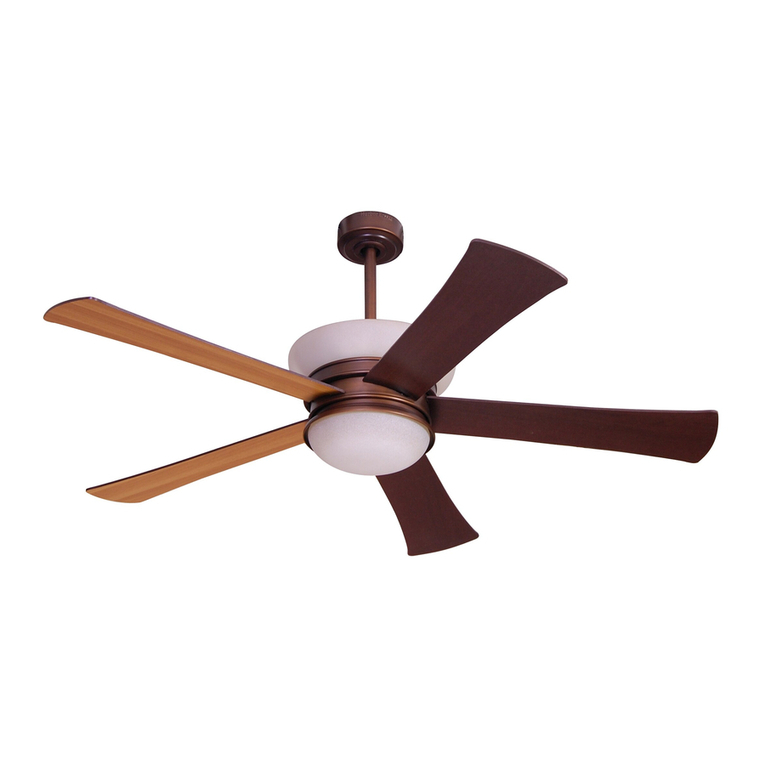
Allen + Roth
Allen + Roth L1405 instruction manual
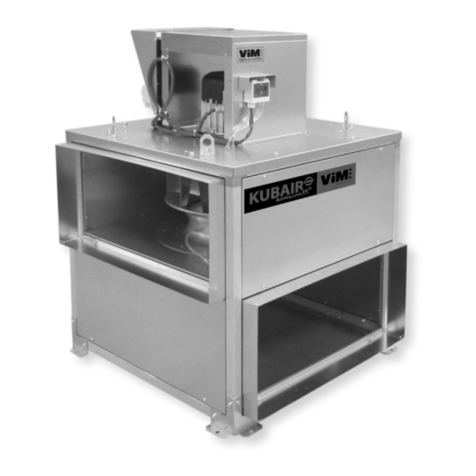
ViM
ViM KUBAIR F400 ECOWATT Technical manual
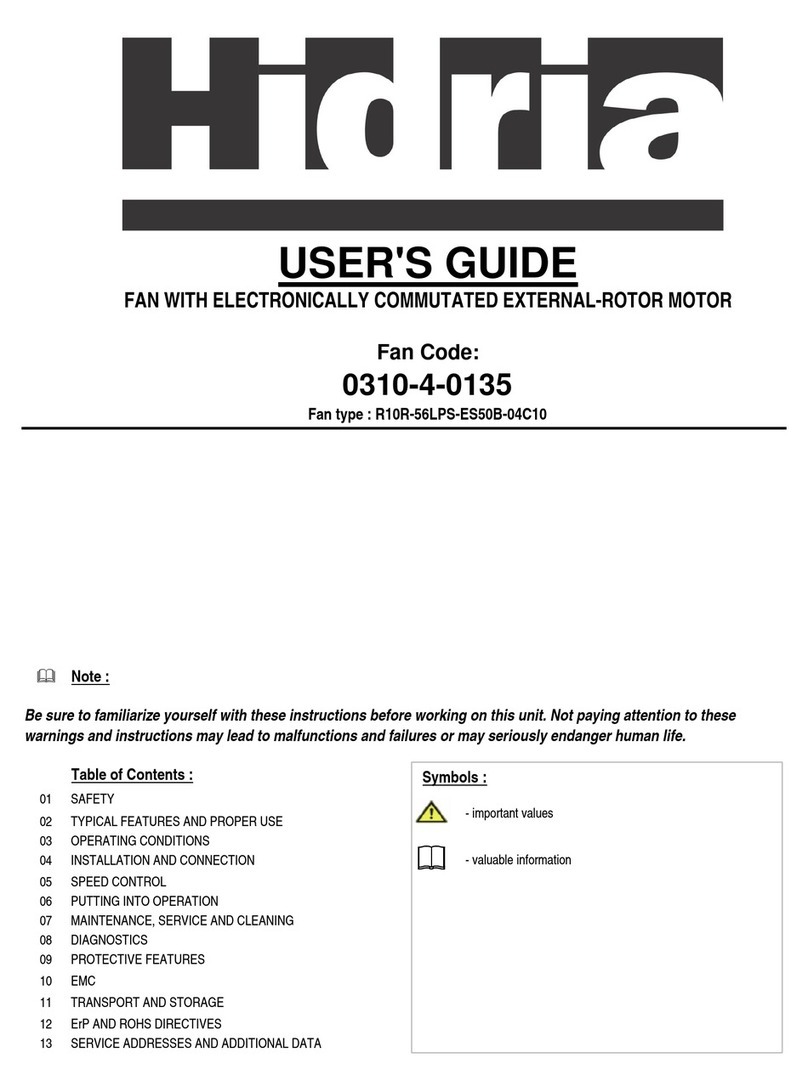
HIDRIA
HIDRIA R10R-56LPS-ES50B-04C10 user guide
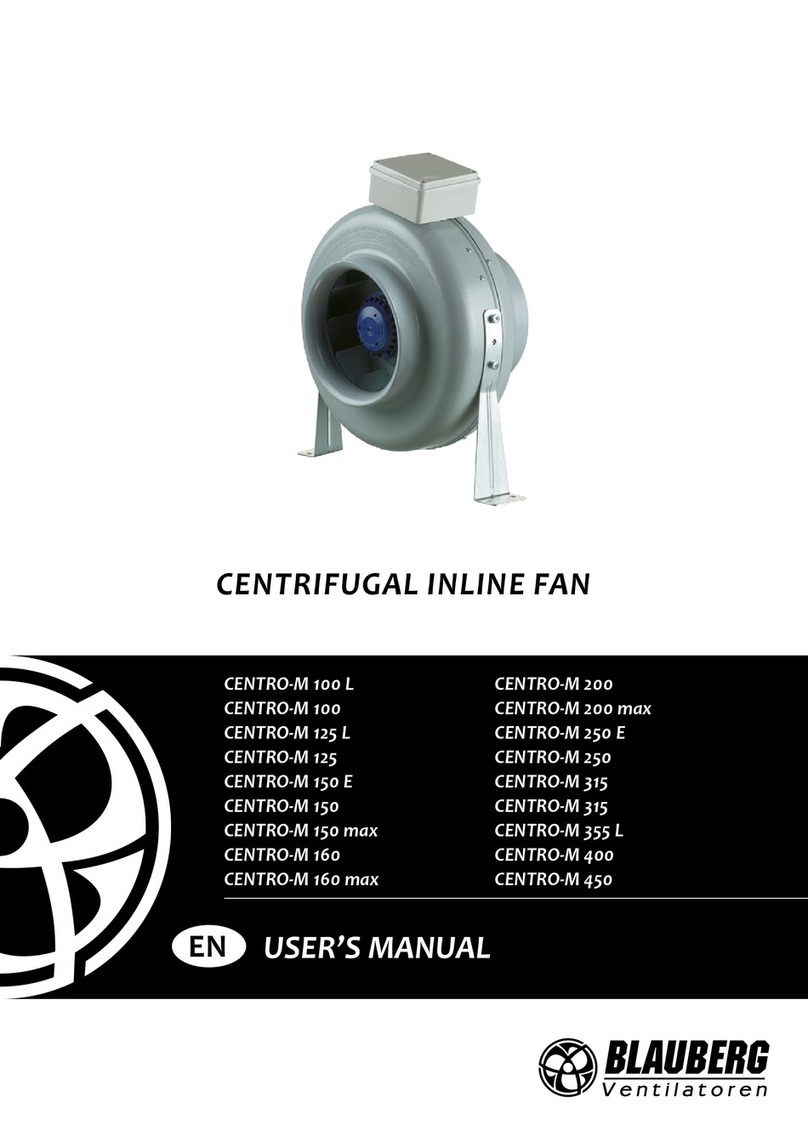
BLAUBERG Ventilatoren
BLAUBERG Ventilatoren CENTRO-M 100 L user manual
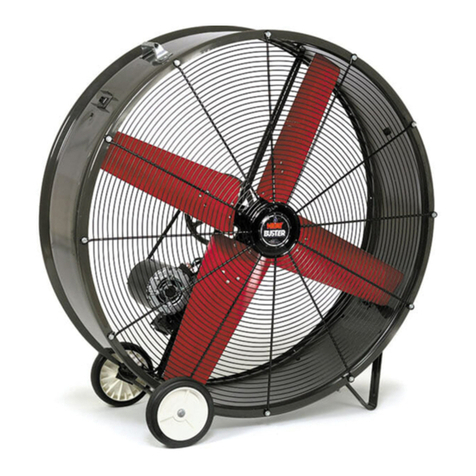
Triangle Engineering
Triangle Engineering HEAT BUSTER SPL Series owner's manual
